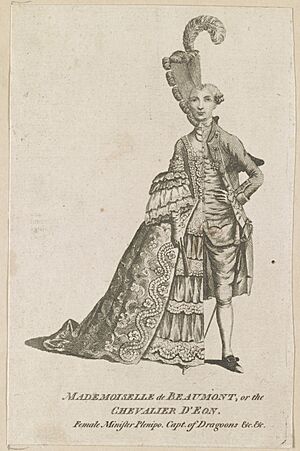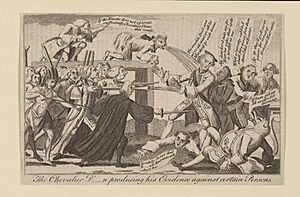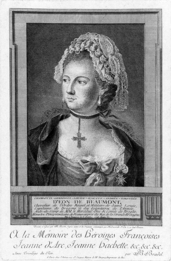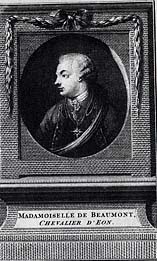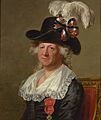Chevalier d'Éon facts for kids
Quick facts for kids
Chevalier d'Éon
|
|
|---|---|
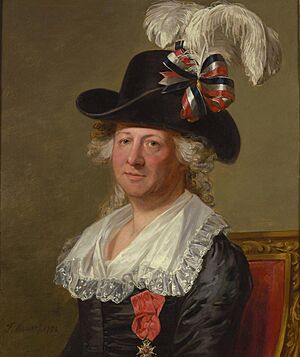
Chevalier d'Éon wearing the Order of Saint Louis, a top French military honor. Painting by Thomas Stewart (1792).
|
|
| Born | 5 October 1728 Tonnerre, Yonne, France
|
| Died | May 21, 1810 (aged 81) London, United Kingdom
|
| Resting place | St Pancras Old Church |
Charles d'Éon de Beaumont (born October 5, 1728 – died May 21, 1810), often called the Chevalier d'Éon, was a fascinating French diplomat, spy, and soldier. D'Éon was known for living publicly as a man for many years, but also successfully worked as a spy disguised as a woman. Later in life, d'Éon lived as a woman and was recognized as such by King Louis XVI. D'Éon played a secret role in French politics and wars.
Contents
Early Life and Education
D'Éon was born in Tonnerre, Burgundy, France. D'Éon's family was part of the French nobility, but they were not very rich. D'Éon's father, Louis d'Éon de Beaumont, was a lawyer and worked for the king. D'Éon's mother, Françoise de Charanton, came from a family of military leaders.
Most of what we know about d'Éon's early life comes from an autobiography. It was partly written by someone else and is called The Interests of the Chevalier d'Éon de Beaumont.
D'Éon was a very good student. D'Éon moved to Paris in 1743 and finished studies in law at the Collège des Quatre-Nations in 1749. D'Éon was 21 years old at the time.
Early Career
D'Éon started working as a writer, contributing to a literary magazine. D'Éon became known for writing about money and government issues in 1753.
Later, d'Éon became a secretary for important government officials in Paris. In 1758, d'Éon was appointed a royal censor for history and literature. This meant d'Éon approved books before they were published.
Life as a Spy
In 1756, d'Éon joined a secret group of spies called the Secret du Roi (King's Secret). King Louis XV used this group without his government knowing. Their goals sometimes went against official French policies.
According to d'Éon's own stories, the king sent d'Éon on a secret mission to Russia. The goal was to meet Empress Elizabeth and work with people who supported France. At that time, the English and French were rivals. The English tried to stop French people from reaching the Empress. They only allowed women and children to cross the border into Russia.
D'Éon claimed to have traveled disguised as a woman, named Lia de Beaumont. D'Éon said this was to avoid being caught by the English. D'Éon then served as a maid of honor to the Empress. However, many historians now believe this story was made up later. It was likely used to show how being seen as a woman had helped France in the past.
D'Éon became a secretary at the French embassy in Saint Petersburg. D'Éon worked there from 1756 to 1760.
D'Éon returned to France in October 1760. D'Éon received a pension for the work in Russia. In May 1761, d'Éon became a captain in the dragoons. D'Éon fought in the later parts of the Seven Years' War. D'Éon was wounded in battle in July 1761.
After Empress Elizabeth died in 1762, d'Éon was considered for more work in Russia. But instead, d'Éon was sent to London as a secretary. The job was to help write the peace treaty that ended the Seven Years' War. The treaty was signed in February 1763. D'Éon received more money and the Order of Saint-Louis. This made d'Éon the Chevalier d'Éon, a title like 'knight'.
Back in London, d'Éon became the temporary ambassador in April 1763. D'Éon used this position to spy for the king. D'Éon gathered information for a possible French invasion of Britain. This was a secret plan by Louis XV that his own ministers didn't know about. D'Éon also made friends with English nobles.
When a new ambassador arrived in October 1763, d'Éon was demoted. D'Éon felt disrespected and refused to return to France. The British government would not send d'Éon back to France. D'Éon's pension was stopped in 1764.
To keep a position in London, d'Éon published secret letters in March 1764. These letters were about d'Éon's recall and criticized the new ambassador. This was a huge scandal in diplomacy. But d'Éon still had more secret documents. This made the French government careful in how they dealt with d'Éon.
D'Éon was declared an outlaw for not defending against a libel lawsuit. But the British public supported d'Éon. D'Éon then wrote a book about government, published in 1774.
In July 1766, King Louis XV gave d'Éon a new pension. This was likely to keep d'Éon quiet. D'Éon continued to work as a spy but lived in exile in London. D'Éon's secret letters protected d'Éon from further trouble. D'Éon became a Freemason in 1768.
Life as a Woman
Even though d'Éon usually wore a soldier's uniform, rumors spread in London. People wondered if d'Éon was actually a woman. A betting pool was even started about d'Éon's true gender. D'Éon refused to be examined, saying it would be dishonoring.
After King Louis XV died in 1774, the secret spy network was ended. D'Éon tried to arrange a return from exile. A writer named Pierre de Beaumarchais helped the French government with the talks. A treaty was made, allowing d'Éon to return to France. D'Éon could keep the pension but had to give back the secret letters.
D'Éon claimed to have been assigned female at birth. D'Éon said this was because the father could only inherit if he had a son. King Louis XVI and his court agreed to recognize d'Éon as a woman. But they required d'Éon to dress in women's clothing. D'Éon was still allowed to wear the medal of the Order of Saint-Louis.
The king even offered money for a new wardrobe of women's clothes. D'Éon agreed. In 1777, after long talks, d'Éon returned to France. As a punishment for past actions, d'Éon was sent to live in Tonnerre.
When France began helping the American rebels in their war for independence, d'Éon wanted to join the French troops. But d'Éon's banishment prevented it. In 1779, d'Éon published a book of memoirs. These were likely written by a friend and probably exaggerated.
D'Éon was allowed to return to England in 1785. The pension from Louis XV ended with the French Revolution. D'Éon had to sell personal items to make money. The family's properties in Tonnerre were taken by the new government.
In 1792, d'Éon offered to lead a group of female soldiers against enemies of France. But the offer was turned down. D'Éon continued to participate in fencing tournaments. D'Éon was seriously hurt in 1796.
D'Éon spent the last years living with a widow, Mrs. Cole. In 1804, d'Éon was sent to a debtors' prison for five months. D'Éon became paralyzed after a fall. D'Éon spent the last four years bedridden and died in poverty in London on May 21, 1810. D'Éon was 81 years old.
D'Éon was buried in the churchyard of St Pancras Old Church. D'Éon's remaining belongings were sold in 1813.
Legacy
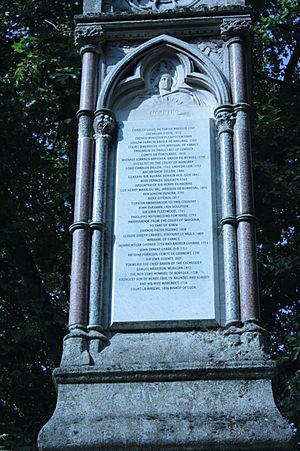
Some of d'Éon's papers are kept at the Brotherton Library in Leeds, England.
Some modern experts see d'Éon as transgender. The Beaumont Society, a group for transgender people, is named after d'Éon.
In 2012, a painting from 1792 was identified as a portrait of d'Éon. It was bought by the National Portrait Gallery, London.
The Burdett-Coutts Memorial in London remembers d'Éon and other important people. In 2016, it was recognized as a historically important structure.
Cultural Depictions
The Chevalier d'Éon has appeared in many stories, films, and music.
- The pop song "Sans contrefaçon" by Mylène Farmer mentions the Chevalier d'Éon.
- The Chevalière d'Eon (1837) and The Chevalier d'Eon (1837) were comedies.
- Le chevalier d'Eon (1908) was an opera.
- Spy of Madame Pompadour (1928) was a film.
- Le secret du Chevalier d'Éon (1959) was a film that showed d'Éon as a woman pretending to be a man.
- By Plume and Sword (1963) is a novel based on d'Éon's time in Russia.
- Beaumarchais (1996) is a film that shows d'Éon's negotiations with Pierre de Beaumarchais.
- Le Chevalier D'Eon (2006) is an anime series loosely based on d'Éon.
- The Sword of the Chevalier (2017) is an episode of the Doctor Who audio series.
- D'Éon appears as a character in the game Assassin's Creed: Unity.
- The Chevalier d'Éon: The 18th Century Transgender Spy (2022) is a short documentary.
- Innocent (2013–2015) is a Manga series that briefly shows d'Éon.
- D'Éon is a character in the video game Fate/Grand Order.
- Franklin (2024) is a miniseries where d'Éon meets Benjamin Franklin.
Images for kids


